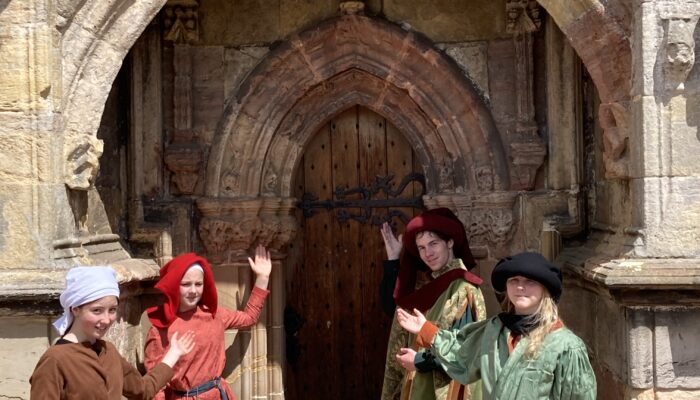Human remains reinterred in Rosslyn Chapel grounds

November 16, 2015
Human remains, which were uncovered inside Rosslyn Chapel, during recent conservation work, have been reinterred in the Chapel grounds. Articulated skeletal remains were uncovered when work was undertaken to renew the heating system, requiring the removal of floor slabs and a small amount of excavation. Remains of three skeletons were exposed inside the Chapel. A number of discrete ground impacts were also monitored in the Chapel Precinct and a small amount of disturbed bone was recovered.
The radiocarbon dating of two adult skeletons interred within the Chapel indicates that the burials dated to the mid-15th century, around the time of the construction of the building. It is possible that these were individuals of some status associated with the earliest period of the Chapel and buried in a high status location within the Chapel. The skeletal remains suggest both were male and that at least one of the individuals had undertaken heavy or repetitive physical activity, with well-developed bone surfaces at the sites of muscle insertions.
The heads of the skeletons found inside the Chapel were positioned to the west with the feet to the east, indicative of normal medieval Christian practice, whereby on the Day of Judgment, the dead could arise to face the rising sun. It was common for members of the clergy to have the opposite alignment with the head to the east, so that on the Day of Judgment they would arise to face their congregation. This would suggest the burials are not of the clergy.
Analysis of the remains of the skeleton found in the Chapel Precinct shows that it dated to between the 15th and 17th centuries. Similarly, the skeletal remains of this adult male appear to indicate that he had undertaken physical activity.
The archaeology and analysis were managed on behalf of Rosslyn Chapel Trust by AOC Archaeology group, of Loanhead, Midlothian. Archaeologists prepared the bones for reburial in accordance with guidelines set by Historic Environment Scotland.
Lindsay Dunbar, Fieldwork Project Manager, AOC Archaeology Group, said: ‘Opportunities to work at such a world famous and iconic monument as Rosslyn Chapel come along rarely so it was with great anticipation that AOC undertook the archaeological monitoring during the construction of the new visitor centre and works at the Chapel. The discovery of both disturbed and in situ burials was especially exciting given the limited amount of excavation necessary within the chapel to complete the conservation works. AOC was allowed ample time to complete the full excavation of the burials and the good preservation of the human bone allowed full osteoarchaeological analysis to be completed. Whilst it is unlikely that the burials represent the clergy it is clear that to occupy such a space within such a small chapel means that these burials are of people important to the chapel.’
Ian Gardner, Director of Rosslyn Chapel Trust, said: ‘The analysis provides valuable information about the age of the remains but, inevitably, questions remain unanswered about the identity of these men and their roles here. Today’s ceremony to reinter the remains was simple but a very fitting way to return them to Rosslyn Chapel.’
Rosslyn Chapel, in Midlothian, was founded in 1446 by Sir William St Clair and remained unfinished when he died in 1484. The Chapel is a popular visitor destination and remains a working church, as part of the Scottish Episcopal Church.
Posted in Conservation



